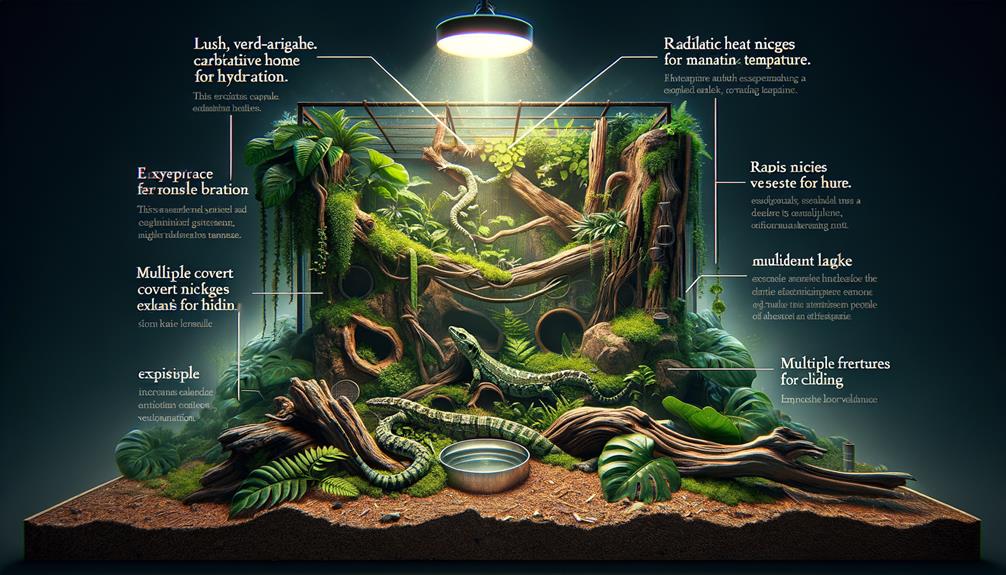When I clean, I remove dirt and organic matter from surfaces, which is crucial before sanitizing and disinfecting. Sanitizing reduces bacteria to safe levels, while disinfecting kills 99.9999% of pathogens, including viruses. High-touch areas like doorknobs and light switches require more frequent attention due to their high germ exposure. Using the right EPA-approved products and following instructions ensures effective sanitation. I always allow the recommended contact time for disinfectants to be fully effective, especially in environments where vulnerable individuals are present. This helps maintain a healthier space and prevents the spread of illnesses.
Key Takeaways
Clean surfaces first to remove dirt before sanitizing or disinfecting. This step ensures that germs aren’t spread around during the disinfection process.
Use EPA-approved disinfectants to effectively eliminate germs. These products have been tested to ensure they kill a wide range of microorganisms.
High-touch surfaces like doorknobs, light switches, and countertops need extra attention. These areas are prone to harbouring germs, so make sure to disinfect them regularly.
Always follow the manufacturer’s instructions for disinfectants. This includes the recommended contact time, which is the amount of time the disinfectant needs to stay on the surface to effectively kill germs. Also, take necessary safety precautions to avoid exposure.
In areas where vulnerable individuals are present, such as hospitals or nursing homes, increase the frequency of cleaning and disinfection. This helps prevent the spread of germs and keeps these individuals safe.
Understanding Cleaning, Sanitizing, and Disinfecting
Before we dive into the specifics, let’s define what cleaning, sanitizing, and disinfecting mean in practice. Cleaning involves physically removing dirt and organic matter from surfaces using water and cleaning agents. This step is crucial because it eliminates the environment where germs and pathogens can thrive.
Sanitizing reduces bacterial contaminants on surfaces to safe levels, typically by 99.999% within 30 seconds. This method is vital for minimizing our exposure to harmful bacteria. Disinfecting takes it a step further by killing 99.9999% of pathogens, including viruses, on surfaces. For both sanitizing and disinfecting to be effective, surfaces must be cleaned first.
Understanding the differences between these methods is vital for achieving effectiveness. Each method serves a unique purpose and requires specific techniques. For instance, high-touch surfaces, like doorknobs or counters, might require more frequent disinfecting due to their higher exposure to germs.
When to Clean Various Surfaces
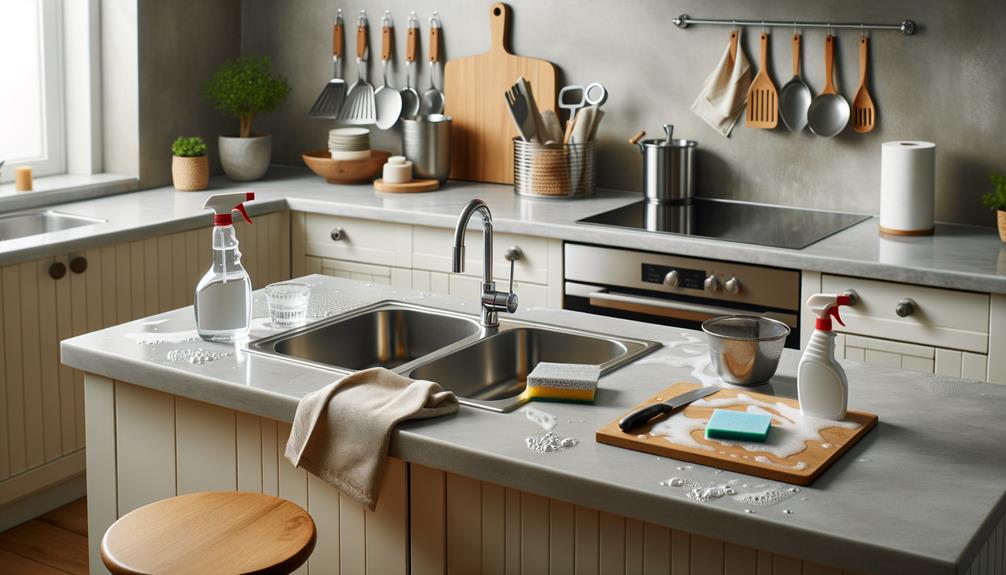
When cleaning various surfaces, I prioritize high-touch areas like doorknobs, light switches, and countertops, especially when someone is sick. I select the right cleaning products for each surface; soap and water work well for hard surfaces, while soft surfaces require specific cleaners. It’s vital to follow care instructions for laundering and manufacturer guidelines for electronics to ensure effective cleaning.
High-Touch Surface Frequency
To maintain a clean environment, establishing a routine for cleaning high-touch surfaces is crucial. This includes surfaces like door handles, light switches, and countertops that are frequently touched. The frequency of cleaning depends on how often these surfaces are used and by how many people. In busy spaces like households or offices, daily cleaning is necessary.
In areas where vulnerable individuals reside, such as the elderly or those with weakened immune systems, increasing the cleaning frequency is vital. Regularly cleaning high-touch surfaces helps prevent the spread of germs and reduces the risk of infections. After contact with sick individuals, immediate disinfection of these areas is necessary to maintain a safe environment.
Cleaning high-touch surfaces regularly is key to promoting health. By sticking to a consistent routine, I can ensure my living or working space remains clean and germ-free. This practice reduces the risk of illness and contributes to overall well-being. A proactive approach to cleaning and disinfecting high-touch surfaces is essential for maintaining a healthy and hygienic environment.
Cleaning Product Selection
Choosing the right cleaning products for different surfaces is crucial for effective sanitation and maintaining the integrity of materials. For routine cleaning of hard surfaces, a simple solution of detergent and water usually does the trick, removing dirt and impurities. However, when it comes to high-touch areas like doorknobs and light switches, using disinfecting products is vital to eliminate germs and protect public health. It’s essential to select products approved by the EPA to combat various pathogens effectively.
When cleaning soft surfaces like carpets and upholstery, use products specifically designed for fabric to avoid damage. Always follow the manufacturer’s instructions and recommendations to maintain the material’s integrity.
Electronics require special care. To sanitize devices without risking damage, follow the manufacturer’s cleaning instructions and use products specifically designed for electronics.
Regularly washing items like bedding and towels is vital. Adhere to care instructions to keep these items clean and prolong their lifespan. By selecting the right cleaning products and following guidelines, we can maintain a healthy environment and protect our belongings.
Effective Sanitizing Practices
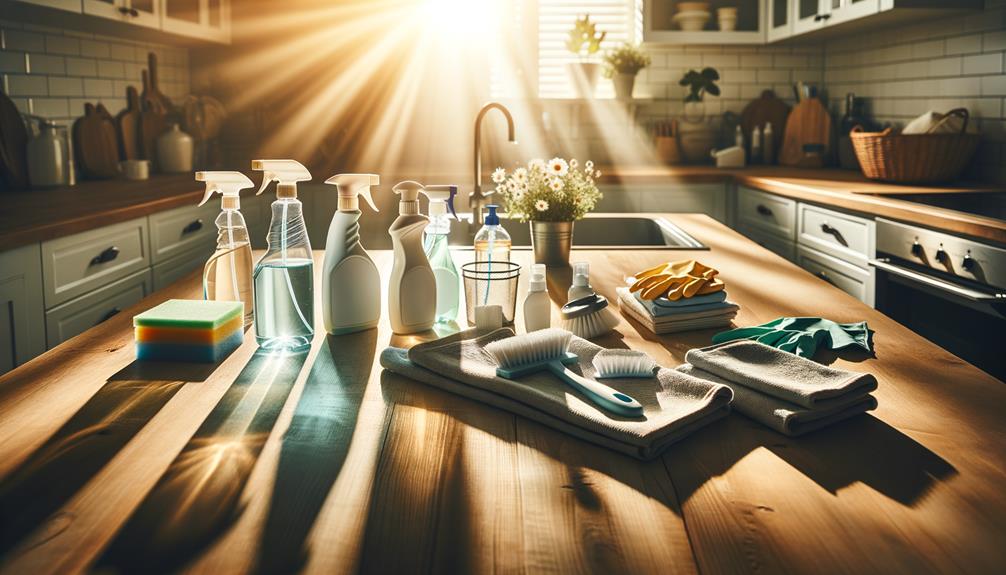
Implementing effective sanitizing practices is crucial for reducing germs to safe levels, especially on high-touch surfaces. I always start with a thorough cleaning to remove dirt and debris. Once cleaned, I use EPA-approved disinfectants, which have been proven to eliminate a wide range of pathogens, including viruses like COVID-19. This ensures that I’m not just moving germs around, but actually getting rid of them.
High-touch surfaces like doorknobs, light switches, and countertops need regular sanitizing to prevent the spread of illnesses. When it comes to food safety, sanitizing food contact surfaces after any incident of contamination is vital. This reduces the risk of foodborne illnesses and keeps our environment safe.
Following the manufacturer’s instructions is key. It’s essential to allow the proper contact time for the disinfectant to work effectively. This ensures that the sanitizing process is thorough and that germs are reduced to safe levels – typically by 99.999% within 30 seconds. By following these steps, I can create a more hygienic and safer space for everyone. By incorporating these methods into my routine, I can confidently maintain a healthier environment.
Disinfecting Guidelines
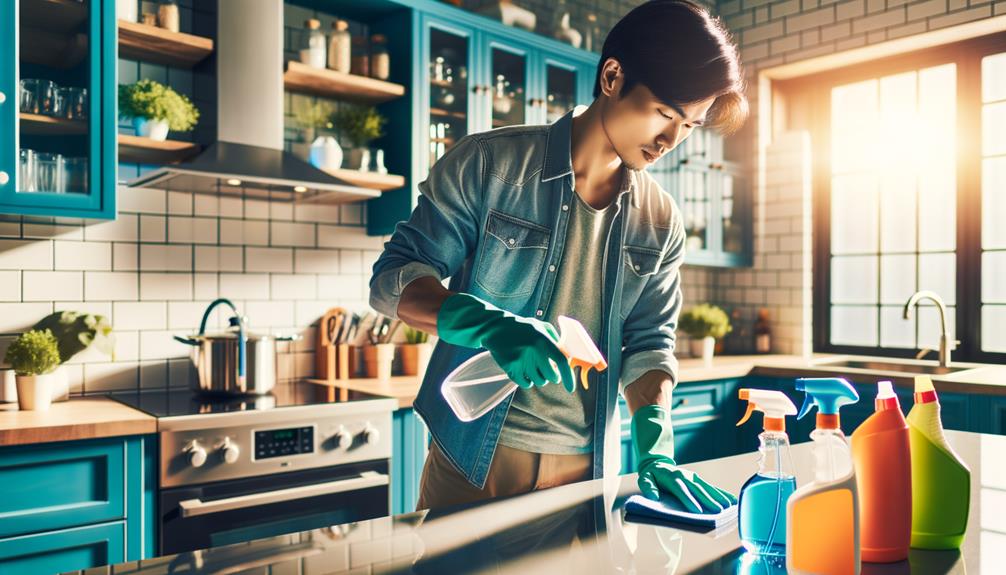
To ensure effective sanitizing practices, it’s crucial to follow proper disinfecting guidelines. This guarantees that surfaces are thoroughly decontaminated and safe. I focus on high-touch surfaces like doorknobs, light switches, and countertops, which require regular disinfection, especially during disease outbreaks. These areas are prone to harboring pathogens, and disinfecting them helps prevent the spread of illnesses.
Using EPA-approved disinfectants is vital. These products have been tested and proven to effectively kill germs, ensuring a hygienic environment. Always read the labels on disinfectants to understand their specific uses and safety instructions. This ensures their effective use and that the disinfectant works as intended.
Proper contact time is key to successful disinfection. This refers to the duration the disinfectant needs to remain on the surface to effectively kill pathogens. Skipping this step can render the whole process ineffective.
Handling and Storing Cleaning Products

Handling and storing cleaning products safely is crucial to maintain their effectiveness and prevent accidents. When storing cleaning products, always keep them in their original containers to ensure proper labeling and instructions are intact. This helps you use them correctly and safely. It’s also vital to keep these products out of reach of children and pets to prevent accidental ingestion or exposure.
Store cleaning products in a cool, dry place, away from direct sunlight to maintain their effectiveness over time. Never mix different cleaning products, as this can lead to harmful chemical reactions or diminish their efficacy.
When it comes to disposing of expired cleaning products, don’t just throw them in the trash. Instead, follow local hazardous waste disposal guidelines to protect the environment and community. Properly handling and storing cleaning products requires attention to detail, but it’s worth the effort. By doing so, you can ensure that your cleaning efforts are both safe and effective, giving you the freedom to enjoy a clean and healthy living space.
Special Considerations for Different Environments
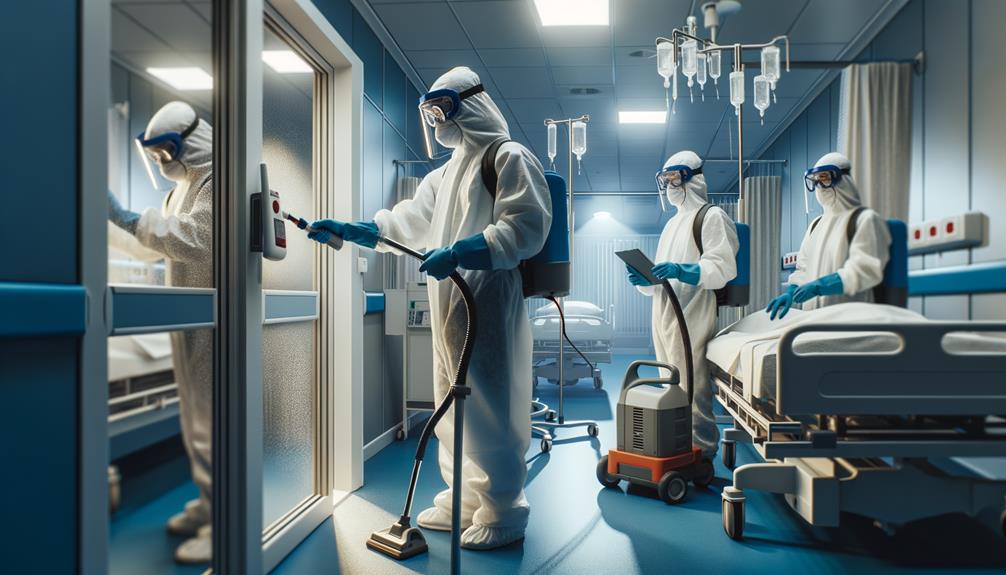
When it comes to cleaning and disinfection, different environments have unique needs. Schools, for instance, require a strong focus on high-touch surfaces to prevent the spread of illness among students. Healthcare facilities, on the other hand, need strict protocols to prevent infections. By adapting our approach to each environment, we can ensure a safe and healthy space for everyone.
Schools and Daycares
Schools and daycares need to prioritize regular cleaning and disinfection of high-touch surfaces like desks, doorknobs, and toys to create a healthy environment where kids can learn and play without worrying about getting sick. This isn’t just about keeping things clean; it’s about preventing the spread of germs among children.
Hand hygiene is key; children and staff should wash their hands frequently and use hand sanitizer when soap and water aren’t available. Covering coughs and sneezes also plays a big role in minimizing the spread of germs. Regular health screenings for both children and staff can catch potential issues early, preventing outbreaks before they start.
Following CDC guidelines helps create effective cleaning and disinfection practices tailored to the specific needs of these environments. This includes paying extra attention to shared items like art supplies, playground equipment, and bathroom fixtures. Good ventilation also helps reduce airborne contaminants. Working with local health authorities ensures that the strategies in place are effective and up-to-date. By following these practices, we can create safer, healthier spaces for our children.
Healthcare Facilities
Healthcare facilities require specialized cleaning and disinfection protocols due to the high risk of germ transmission and the need to prevent healthcare-associated infections (HAIs). In these settings, high-touch surfaces like doorknobs, bed rails, and medical equipment demand frequent attention. I prioritize these areas with rigorous cleaning protocols to ensure patient safety and maintain a sterile environment.
Hospital-grade disinfectants are crucial in these settings. I follow strict guidelines, applying these powerful solutions to eliminate pathogens effectively. My goal is to reduce the spread of HAIs, which can have severe consequences for patients and staff alike.
Disinfection practices in healthcare facilities extend beyond just wiping down surfaces. I ensure that medical equipment is thoroughly cleaned and sanitized, which is essential for devices that come into direct contact with patients, such as surgical instruments and diagnostic tools.
Patient safety is always my top priority. Effective cleaning and disinfection practices are vital for maintaining a sterile environment in healthcare facilities. By implementing and adhering to these protocols, I help protect everyone who enters these critical spaces from potential infections and contribute to overall health and well-being.
Frequently Asked Questions
What Are the Steps for Cleaning and Disinfecting?
I clean surfaces to remove dirt and grime, creating a fresh slate for disinfecting. Next, I apply disinfectants, carefully following the manufacturer’s instructions for proper dilution and contact time to ensure their effectiveness. High-touch areas like doorknobs and light switches get extra attention to thoroughly eliminate germs.
What Is the Difference Between Clean and Disinfecting?
You might think cleaning and disinfecting are the same, but they’re not. Cleaning gets rid of dirt and impurities, while disinfecting kills germs and pathogens using products approved by the EPA. Both steps are crucial for creating a truly hygienic environment.
What Comes First Cleaning or Disinfection?
I clean to remove dirt and organic matter, making sure the disinfectant can work effectively. After cleaning, I disinfect to kill any remaining germs and maintain hygiene.
How Often Should You Clean and Disinfect?
I make it a habit to clean and disinfect my space daily, focusing on high-traffic areas and spots where someone’s been unwell. Kitchens and bathrooms require extra attention, and I pay special attention to doorknobs, switches, and electronics to keep germs at bay.


